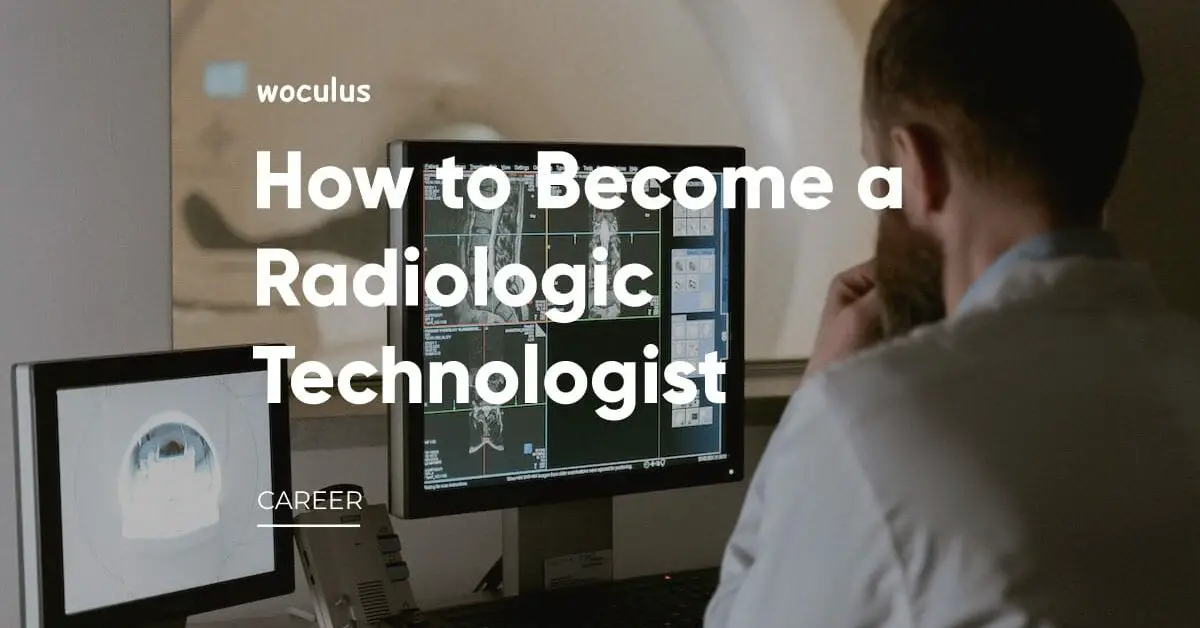Radiologic technologists are medical imaging professionals that provide doctors and physicians with imaging tests like CT scans, X-rays, and MRIs for diagnostic purposes. They work in hospitals, private physician offices, clinics, imaging centers, and other areas in the healthcare industry. They also work with physicians to determine if additional images are required for treatment options.
Table of Contents
Radiology Career Path Overview
Radiology is a field in healthcare that needs skilled workers to provide the right care to patients but it can easily be overlooked by aspiring professionals. Radiologic technologists have technical skills that are essential to healthcare delivery processes. Their understanding contributes to the proper diagnosis of a wide range of injuries, illnesses, disorders, and diseases.
Radiologic technologists can kickstart their careers with a two-year or four-year program, a professional certification, and state licensure. They can work with patients of all ages and proceed to specialize in a specific area of diagnostic imaging like fluoroscopy, mammography, or CT. They can also specialize through higher education and certification.
Radiology Career Path: Radiologic Technologist Skills Checklist
Radiologic technologists need to physically interact with patients of all groups and demographics. The patient must also feel comfortable interacting with them. They should be able to obtain a clear image even when patients are unconscious, in severe pain, or anxious. The job requires specific skills among which are:
Communication Skills
A radiologic technologist must be able to communicate comfortably with patients. Some patients may show fear and anxiety and some may be in excruciating pain or trauma at the time of consultation. Their voice should be calm and compassionate. They should also be able to answer any questions and explain procedures. They should also be able to pick up non-verbal cues.
Mechanical Skills
Working as a radiologic technologist involves handling imaging equipment. You need mastery in handling such equipment and you need to be able to keep up with the technology as it evolves. A radiologic technologist should understand how to adjust radiation exposure and the timing for capture. Other skills needed by a radiologist include equipment maintenance and repair. A radiologic technologist should know which equipment fits certain cases.
Medical Skills
Medical knowledge is necessary for radiologic technologists. You need to understand the human anatomy to rightly position patients for image capture. Radiologic technologists also need to understand safety measures to prevent over-exposure to equipment radiation and fundamental patient care guidelines.
Become a Medical Biller from Home: Comprehensive Guide
Radiology Career Path: Why Choose This Career?
People choose this career path for differing reasons. Many radiologic technologists love the field because they love technology and caring for people, and are not satisfied with either/or option. Radiologic technology gives ample opportunity for them to care for patients while still working with sophisticated medical devices. If you love working with people, even when they are experiencing pain or trauma, you will also enjoy this career path.
Moreover, radiology is a promising career path. Radiologic technologists are well paid and the job prospect for this career path is robust. The more the healthcare industry continues to grow, the higher the demand for radiology experts in diagnosing injuries, illnesses, and diseases. The future of a radiologic technologist’s career is bright on all positive indicators.
There are also different areas in the radiology field. You can specialize in specific diagnostic tests with some additional training, certification, or education. If you only want to work within your area of specialization, opportunities will still abound for you. Specialization helps because of technological advancements in different specialties.
Since it may be too demanding to be up to date with the latest technologies in each field, specializing helps you to gather extensive experience in your chosen area of specialty. For example, after starting as a licensed radiologic technologist, you can focus on magnetic resonance imaging with your MRI certification.
Radiology Career Path: Steps to Become a Radiology Technologist
A radiologic technician operates medical imaging equipment with technical skills. Radiologic technologists are medical professionals who are technically oriented. They are often outgoing and compassionate as they gather experience working with patients under high duress. Anyone who is willing to meet the requirements can become a radiologic technologist. While training to work in this career path, students can specialize in specific fields of imaging technology.
The minimum requirement to become a radiologic technologist is an associate degree but students can work with a bachelor’s or master’s degree in their chosen field. Below is the route to build and maintain a radiologic technologist career:
Educational and Certification
To become a licensed radiologic technologist, you must complete a minimum of a two-year associate degree course in an approved institution. The course and school must be approved by the regulatory body in your state. Ensure that the specific program is recognized in your state before you enroll for it. Some states accept certificates from approved training programs in lieu of an associate degree.
You can search out the certificate and degree programs on campuses, online learning platforms, and hybrid radiology programs. Ensure you can map out time for your studies even if learning is self-paced and stick to your schedule. Upon completion of your study, you can get credentialed on a primary track by the American Registry of Radiologic Technologists (ARRT) through its certifying examination. An associate degree from an ARRT-approved program is the requirement for this primary credential.
Internship or Apprenticeship
Education, licenses, and certifications are important, but not as important as the hands-on experience from practicing as a radiologic technologist. As soon as you can practice, find an internship or apprenticeship opportunity. Work directly with patients. With this experiential learning phase, you can learn the nuances of the theory and its applications. You will be able to manage the demands of your patients with the machine.
Moreover, this is the time for you to explore various fields in radiology for a broader experience which will come in handy long-term. The more opportunities you have with different technologies and patients, the better for you. So, if your desired field is pediatric radiology technology, you may benefit from experiences of radiology in geriatric care. To find opportunities for learning experiences, you can check up with your program or join professional associations in radiology. Actively searching for opportunities within the field can connect you to great jobs.
Certification Maintenance and Advancement
To ensure compliance with ARRT regulations, radiologic technologists are to renew their certifications every two years. This step also authenticates continued adherence to ethical standards and fulfillment of required hours of continuing education. To retain their license or secure additional licenses, radiologic technologists must earn 24 approved continuing education credit hours in two years.
How to Become a Work From Home Medical Coder Without Experience
Careers in Radiology: What Are the Different Fields of Radiologic Technology?
Radiology is a field that combines medical science with advanced technology for medical imaging. It adopts the knowledge of human anatomy, physics, and physiology for creating clear medical images. Radiologic technologists can work as researchers, consultants, educators, and administrators. Career opportunities in this field include:
Diagnostic Medical Sonographer: They use high-frequency soundwaves to show body organs and structure using their advanced knowledge of ultrasound imaging equipment and human anatomy. Radiologic technologists can be trained on the job to specialize as sonographers. However, most employers require certification from the American Registry of Diagnostic Medical Sonographers (ARDMS).
Special Procedure Technologist: Special procedure technologists study the body’s blood vessels with designated x-ray machines. They work with physicians that perform vasodilation procedures using their knowledge of human anatomy and advanced technology. The responsibilities of a special procedure technologist involves image processing, x-ray, patient-monitoring equipment, and computer. ARRT radiography certification is required to work
As a special procedure technologist and state licensure may be required as well.
Radiation Therapist: The radiation therapist treats patients using a radiation beam or source. Radiation therapists also work with radiation oncologists to determine the dosage of radiation a patient is to receive during treatment. The radiation therapist often needs to establish and maintain a supportive relationship with their patients who are getting cancer treatments. In addition to their technical skills, they need to be sensitive and caring. Radiation therapists need to obtain radiation therapy certifications from the American Registry of Radiologic Technologists (ARRT) and may also need state licensure to practice.
Radiology Nurse: Radiology nurses work in breast imaging, CT scan, special procedures and general radiology. They provide specialized and routine nursing care to patients within the radiology departments. Employers typically require certification in conscious sedation, advanced cardiac life support (ACLS), and critical care.
Radiographer: The radiographer is an expert in conducting various x-ray examinations. The radiographer also conducts tests that need the use of contrast agents. They are able to see organs that cannot be seen by x-rays with contrast agents. Most employers require radiographers to have certification by the American Registry of Radiologic Technologists (ARRT) and state licensure.
Mammographer: Mammographers create clear images for oncologists, radiologists and other health care professionals. With ionizing radiation, they produce images of the breast that the professionals screen for diagnosis and treatment purposes. Mammographers need to be skilled in making their patients comfortable as it can be a painful process. Most mammographers obtain advanced certification from the American Registry of Radiologic Technologists (ARRT). Some states also require licensure.
Magnetic Resonance Imaging (MRI) Technologist: MRI technologists create body images using powerful magnets, radio waves and computers. They are required to understand cross sectional human anatomy and have excellent computer skills. MRI technologists need radiographer certification by the American Registry of Radiologic Technologists (ARRT). Some states require licensure and advanced certification.
Computed Tomography (CT) Technologist: CT technologists take detailed cross-sectional images of the body’s internal structure using advanced computerized x-ray equipment. Their contribution helps with patient diagnosis and treatment. To work as a CT technologist, you need at least a radiographer certification by the American Registry of Radiologic Technologists (ARRT) and may also need to obtain state licensure.
Picture Archival and Communication Systems (PACS) Administrator: PACS admin implement, maintain and update radiologic picture archival and communication systems. They work with radiology staff to ensure that computer systems generating images about exams, results and histories are well maintained. The job function of a PACS admin cuts across different radiology departments and their imaging equipment. They also make images available on request to authorized users. Computer training and radiology experience are required to work as a PACS administrator.
Radiology Career Path: Alternative Jobs for Radiologic Technologists
Some radiologic technologists can opt to work outside the healthcare industry and branch into the businessworld. They can open and run their laboratories with the necessary certifications and approvals. They can also work in various capacities in education, marketing and management fields. They can work as consultants for medical-oriented business or in sales. The kind of opportunities one can explore as a radiologic technologist depend on the experience and educational background.
Radiology Careers and Salaries: Radiology Technician Salary
As the healthcare industry continues to witness an explosive growth, the career outlook for radiology technicians is really positive. Moreover, rad techs can branch outside the healthcare industry and still build successful careers. According to the U.S. Bureau of Labor Statistics (BLS), the radiologic technologist career path has a faster-than-average growth projection.
The opportunity to earn high salaries and find better job openings is on the rise in this field. The BLS reports the median wage for radiologic technologists as over $61,980 in 2021 while Payscale fixes it at around $80,000 per year in 2023. The salary reports for specific jobs in radiology differ. For example, while MRI technologists are reported by BLS to have earned the median pay of $61,980 in 2021 radiation therapists earned $82,790 in the same year.
Radiologic technologists who obtain higher education and go as far as earning a master’s degree or full medical degree can earn an average salary of over $300,000 per year. The BLS projects a 6% growth in this field until 2031 with over 16,000 job openings each year over the next decade.
Conclusion
There is no limit on how far you can go and grow as a radiologic technologist. As you consider this career path, you can map out a plan for your education, certification, licensure and internship. Research available programs, join professional communities and link up with others in your field to get access to the latest and best job opportunities.
While this job has a favorable growth potential, competition can be stiff for the juicy offers, so you want to ensure you are equipped with the necessary skills and experience to appeal to employers. It will take a lot of hard work to establish yourself on this career path, but you will see it pay off in your earnings and career development.







